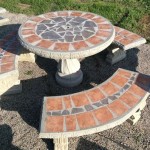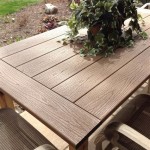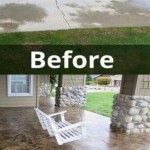Raised Garden Beds on Concrete Patios: A Practical Guide
The desire to cultivate a garden often conflicts with the realities of limited space or the absence of suitable soil. For apartment dwellers, homeowners with primarily paved yards, or individuals with mobility constraints, the traditional in-ground garden may not be feasible. Raised garden beds offer a viable and often aesthetically pleasing alternative, particularly when placed on concrete patios. This approach allows for controlled soil conditions, improved drainage, and easier accessibility, transforming otherwise unusable spaces into vibrant, productive gardens.
The feasibility of establishing raised garden beds on concrete patios hinges on careful planning, proper material selection, and an understanding of the unique challenges posed by this specific environment. Unlike in-ground gardens, raised beds on concrete rely entirely on the structure itself to contain the soil and manage water flow. This necessitates considering factors such as weight distribution, drainage, material durability, and the potential impact on the concrete surface.
This article will explore various aspects of creating and maintaining successful raised garden beds on concrete patios, focusing on key considerations and best practices. It will address factors influencing the choice of materials, the importance of proper drainage, the methods for mitigating potential damage to the concrete, and the specific gardening techniques that are best suited for this type of setup. Successful implementation of these guidelines ensures a thriving garden while preserving the integrity of the underlying patio surface.
Key Point 1: Material Selection and Construction
Choosing the right materials for a raised garden bed is crucial, as it directly impacts the structure’s longevity, its aesthetic appeal, and its impact on the surrounding environment. Several options exist, each with its own advantages and disadvantages. Understanding these differences is essential for making an informed decision that aligns with individual needs and preferences.
Wood: Timber is a commonly used material for raised beds due to its relative affordability and ease of construction. However, not all wood is created equal. Untreated wood is susceptible to rot and decay, particularly when exposed to constant moisture. Pressure-treated lumber, while more durable, contains chemicals that may leach into the soil, potentially posing a risk to plants and, consequently, to anyone consuming them. Cedar and redwood offer a naturally rot-resistant alternative, though they tend to be more expensive. When using wood, consider lining the interior of the bed with a waterproof membrane to prolong its life and minimize soil contact with the wood itself. Recycled wood, if sourced responsibly and free of harmful chemicals, can be an environmentally conscious choice.
Metal: Metal raised beds, typically made of galvanized steel or aluminum, offer excellent durability and resistance to rust and corrosion. They are often pre-fabricated, simplifying the construction process. Metal beds are less likely to harbor pests and diseases compared to wooden structures. However, they can conduct heat, potentially overheating the soil in hot climates. A light-colored paint or a reflective coating can help mitigate this issue. Metal beds can also be more expensive than wood options. The thin walls of some metal beds may also require internal bracing to withstand the pressure of moist soil.
Composite Materials: Composite materials, made from recycled plastic and wood fibers, represent a sustainable and low-maintenance option. They are resistant to rot, insects, and moisture damage, and they do not require painting or staining. Composite materials often mimic the appearance of wood, offering an aesthetically pleasing alternative. However, they can be more expensive than wood and may not be as structurally strong. It is crucial to choose a high-quality composite material that is specifically designed for outdoor use and is certified to be free of harmful chemicals.
Concrete Blocks/Bricks: Concrete blocks or bricks provide a sturdy and long-lasting option for creating raised beds. They offer excellent thermal mass, helping to regulate soil temperature. They are relatively easy to assemble, requiring minimal cutting or shaping. However, they can be heavy and difficult to move once constructed. Concrete can also leach lime into the soil, potentially raising the pH level. It is important to monitor the soil pH and adjust accordingly. Concrete blocks and bricks also require a level base for stable construction.
The construction process itself should prioritize stability and water tightness. Proper joints and secure fastenings are essential to prevent the bed from collapsing or leaking. Consider the weight of the soil when determining the size and height of the bed. Taller beds will require more internal support to prevent bowing or bulging. It is also advisable to elevate the bed slightly off the concrete surface using spacers or feet. This allows for air circulation and prevents moisture from becoming trapped between the bed and the patio, reducing the risk of damage to both.
Regardless of the material chosen, a critical step is to ensure that the interior of the raised bed is lined with a durable, waterproof membrane. This membrane serves multiple purposes: it protects the bed material from constant moisture exposure, prevents soil from leaching into the concrete, and inhibits weed growth. Choose a food-grade plastic liner or a geotextile fabric specifically designed for gardening applications. Secure the liner to the interior walls of the bed, ensuring a tight seal to prevent water from seeping behind it.
Key Point 2: Drainage and Waterproofing Considerations
Effective drainage is paramount for the health of plants grown in raised beds on concrete patios. Unlike in-ground gardens where excess water can naturally drain into the surrounding soil, raised beds on concrete rely entirely on the drainage system incorporated into their design. Poor drainage can lead to waterlogged soil, root rot, and ultimately, plant failure. Conversely, insufficient waterproofing can damage the concrete patio itself.
The primary goal of drainage is to allow excess water to escape the soil without carrying away valuable nutrients or causing soil erosion. Several strategies can be employed to achieve this. The most fundamental is the inclusion of drainage holes in the bottom of the raised bed. The size and number of these holes should be proportional to the size of the bed and the type of soil used. As a general guideline, holes spaced approximately 6 to 12 inches apart are usually sufficient. Covering these holes with a layer of landscape fabric prevents soil from clogging them while allowing water to pass through freely.
Below the drainage holes, a layer of drainage material should be placed. This layer acts as a reservoir for excess water, allowing it to drain gradually and preventing the soil above from becoming waterlogged. Gravel, crushed stone, or even recycled plastic bottles can be used for this purpose. The depth of the drainage layer should be at least several inches, depending on the size of the bed and the local climate. In regions with heavy rainfall, a deeper drainage layer may be necessary.
The type of soil used in the raised bed also plays a crucial role in drainage. A well-draining soil mix typically consists of equal parts topsoil, compost, and a drainage amendment such as perlite or vermiculite. Avoid using heavy clay soil, as it tends to retain water and can impede drainage. The soil mix should be loose and porous, allowing water to flow freely through it. Regular amendment with compost helps to improve soil structure and drainage over time.
Waterproofing is equally important to protect the concrete patio from moisture damage. Constant exposure to water can lead to cracking, spalling, and the growth of mold and mildew. The waterproof liner described earlier prevents direct contact between the soil and the concrete. However, it is also important to address the potential for water to seep between the raised bed and the patio surface. Elevating the bed slightly off the concrete using spacers or feet allows for air circulation and prevents moisture from becoming trapped.
Applying a concrete sealer to the patio surface before placing the raised bed can provide an additional layer of protection. Choose a high-quality sealer that is specifically designed for outdoor use and is resistant to water and salt damage. Reapply the sealer periodically, as recommended by the manufacturer, to maintain its effectiveness. Regular inspection of the patio surface around the raised bed can help identify any signs of water damage early on, allowing for prompt repairs to prevent further deterioration.
Another consideration is the placement of the raised bed in relation to existing drainage systems on the patio. Avoid placing the bed directly over drains or in areas where water tends to accumulate. Ensure that water can flow freely around the bed and away from the patio surface. Consider installing a small lip or barrier around the base of the bed to prevent water from splashing onto the patio during watering or rainfall.
Key Point 3: Plant Selection and Gardening Techniques
Selecting the right plants and employing appropriate gardening techniques are essential for maximizing the success of raised garden beds on concrete patios. The confined space and the unique environmental conditions of this setup necessitate careful consideration of plant size, root structure, water requirements, and sunlight exposure.
Plant size is a critical factor in determining the suitability of a plant for a raised bed. Avoid choosing plants that will outgrow the available space or develop extensive root systems that can become root-bound. Compact or dwarf varieties of vegetables, herbs, and flowers are often the best choice for raised beds. Consider the mature size of the plant when making your selection and space them accordingly to allow for adequate air circulation and sunlight penetration.
Root structure is another important consideration. Plants with shallow root systems, such as lettuce, spinach, and herbs, are well-suited for raised beds. Plants with deep taproots, such as carrots and parsnips, may require taller beds to accommodate their root growth. If you are growing plants with deep taproots, choose a raised bed with a depth of at least 18 inches. Also, be mindful of invasive root systems that could potentially damage the bed structure or even the concrete patio. Bamboo and certain types of mint are examples of plants with aggressive roots that should be grown in containers rather than directly in the raised bed.
Water requirements vary widely among different plant species. Grouping plants with similar water needs together can simplify irrigation and prevent overwatering or underwatering. Drip irrigation or soaker hoses are efficient methods for delivering water directly to the roots of plants, minimizing water waste and reducing the risk of fungal diseases. Monitor the soil moisture regularly and adjust watering accordingly, especially during hot or dry weather. Adding a layer of mulch around the plants helps to retain moisture in the soil and suppress weed growth.
Sunlight exposure is a crucial factor in plant growth. Most vegetables and flowering plants require at least six hours of direct sunlight per day. Observe the amount of sunlight that the patio receives throughout the day and choose plants accordingly. If the patio is partially shaded, select plants that tolerate partial shade, such as lettuce, spinach, and certain herbs. Consider using reflective surfaces to increase the amount of sunlight that reaches the plants. White walls or reflective screens can bounce sunlight onto the garden, increasing light intensity in shaded areas.
Soil fertility is another important aspect of successful gardening in raised beds. The soil mix should be rich in organic matter and essential nutrients. Amend the soil regularly with compost, aged manure, or other organic fertilizers. Perform a soil test periodically to determine the pH level and nutrient content. Adjust the soil pH as needed to ensure that it is within the optimal range for the plants being grown. Choose fertilizers that are specifically formulated for vegetables, herbs, or flowers, depending on the type of plants being cultivated.
Vertical gardening techniques can be particularly effective in raised beds on concrete patios, especially in limited spaces. Trellises, arbors, or hanging baskets can be used to grow vining plants such as tomatoes, cucumbers, and beans. Vertical gardening maximizes the use of available space and can also improve air circulation around the plants, reducing the risk of fungal diseases. Ensure that the supports are sturdy enough to withstand the weight of the plants as they grow.
Controlling pests and diseases is an ongoing challenge in any garden. Regularly inspect the plants for signs of pests or diseases and take action promptly to prevent them from spreading. Use organic pest control methods whenever possible, such as handpicking pests, using insecticidal soap, or introducing beneficial insects. Avoid using broad-spectrum pesticides, as they can harm beneficial insects and disrupt the ecosystem. Practice crop rotation to prevent the buildup of soilborne diseases. Remove diseased plant material promptly to prevent it from infecting other plants.

Raised Bed On Concrete Yes Or No Epic Gardening

How To Garden In Raised Beds On Pavement Tenth Acre Farm

Raised Beds On Concrete Pad Backyard

Raised Bed On Concrete Yes Or No Epic Gardening

How To Build A Raised Garden Bed On Concrete Patio Or Hard Surface Homestead And Chill

Raised Wooden Garden Beds How To Build Them Around Your Patio Diy Couple Blog

10 Diy Raised Garden Bed Ideas For Your Backyard

How To Build A Raised Garden Bed On Concrete Patio Or Hard Surface Homestead And Chill

Patio Garden Beds On Concrete Or Gravel Yes Durable Greenbed

Raised Stamp Concrete Flower Beds Scravings Vegetable Bed Patio Landscaping House Landscape Flowers








